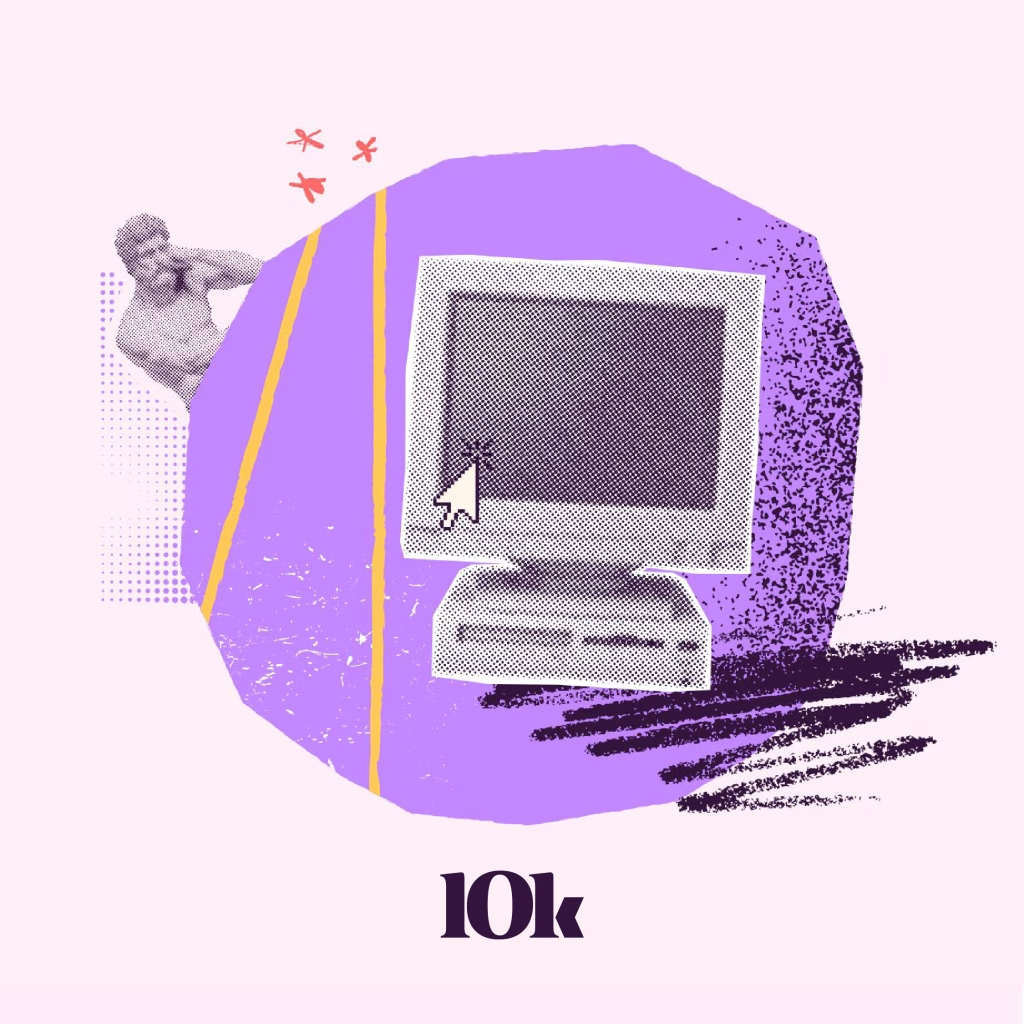During the global recession of 2007 and 2008, Apple brought the iPhone to market and Netflix launched streaming services — two technologies that have reshaped our understanding of digital experiences.
As we move forward through this pandemic, companies are looking to harness that same creativity to innovate. Earlier this year, we hosted a series of roundtables discussing how businesses can adapt and thrive in times of uncertainty.
On this episode of Ten Thousand Feet, Principal Consultant Todd Jacobs and Practice Lead Andrew Powell discuss how businesses can deal with uncertainty, what lessons we can learn from the past and why now is actually a perfect time to innovate.
Enjoy!
This podcast content was created prior to our rebrand and may contain references to our previous name (OST) and brand elements. Although our brand has changed, the information shared continues to be relevant and valuable.
Episode Transcript
Andrew Powell: Hey, everybody. Welcome to “Ten Thousand Feet.” On this episode, we’ll talk to Todd Jacobs, a principal at OST, who works with our clients on a variety of digital transformation projects. Todd talks through the topic of reinvention and how companies can continue to adapt and thrive in times of uncertainty. Enjoy.
So Todd Jacobs, I’m so glad you could join us today and talk a little bit about, well, about what’s going on in the world right now. Todd, how you doing?
Todd Jacobs: I’m doing well, Andrew. Thank you for having me today.
View Full Transcript
Andrew Powell: Todd, you’re a Principal Consultant here at OST, yeah?
Todd Jacobs: I am.
Andrew Powell: So what’s that?
Todd Jacobs: Principal Consultant, man, takes on many different definitions. Really, we serve as a conduit between our delivery organization and our sales organization, both from a strategic guidance perspective, getting into some of the next level conversations of how and where we’re executing on our engagements for clients, again, both at a strategic and tactical perspective, but, really, offering and representing the breadth of OST services, and bringing that to the forefront for our clients, making sure that we’re maximizing the value prop, that we’re meeting our demands. And we do kind of serve as a multifaceted role across the organization, so it’s kind of a unique spot to be in within a company, and one that—
Andrew Powell: Sure.
Todd Jacobs: definitely lends itself to wearing many many hats on any given day.
Andrew Powell: Wow. So you’ve got your hands full it sounds like.
Todd Jacobs: Absolutely do.
Andrew Powell: So let’s talk a little bit about strategy. You help our clients think through their own strategy, is that a thing you do?
Todd Jacobs: Well, I think it’s our strategy, but also mirrored to what we see across the marketplace, what we’ve seen other clients’ case examples, where we’ve delivered in certain, in similar scenarios where we have to be largely innovative in their respective business or the problem that they’re facing—
Andrew Powell: Right.
Todd Jacobs: down to framing that in the first place, and carrying that through where we can inject, where we can help, and really maximizing how OST can help them in their digital journey.
Andrew Powell: Sure. And that digital journey has taken a sort of turn in the last six months, right? Now we’re talking about digital journeys in the wake of a pandemic.
Todd Jacobs: Oh, absolutely. That digital journey, the path that these businesses are on given the global pandemic with COVID, has fundamentally shifted the marketplace in terms of how we are engaging with customers, where we’re being innovative specifically. One of the hot button issues is where budgets are being allocated, that seems to be one of the foremost topics that any business leader will bring to fruition when they talk economic uncertainty is how and where their cash flow is positioned, and where they’re gonna be tomorrow in that whole position—
Andrew Powell: Yeah.
Todd Jacobs: as well. Yeah. A lot of uncertainty in that, yet at the same time, where we’ve had a tremendous opportunity to have conversations, and, again, that strategic guidance that I refer to is how best to innovate, and how best to think about digital and IT spending, and maximize that space again, so that we’re creating competitive advantages despite this uncertainty.
Andrew Powell: So that’s great, Todd. So I know that you and your peers hosted a round table a few months back about thriving in a period of economic uncertainty. How do you feel about that? Do you think thriving in a period of economic uncertainty is possible?
Todd Jacobs: Absolutely. It absolutely is. Thriving is—it’s a keyword in that whole dynamic, Andrew. The fact of the matter is it’s arguably an easy time to forego innovation when business is thriving in the first place without a recession entering into the fold. You’re maximizing product, so your revenues and your margins and your targets are being met full force. Largely, businesses don’t tend to innovate in those spaces. They keep riding that wave.
Andrew Powell: Yeah.
Todd Jacobs: And one of the tremendous opportunities that we’ve been advocating for and have had a number of conversations around is, now more than ever, in these times of uncertainty, is the absolute time. Do you think about reshaping your business from a digital perspective from strategic initiatives, from operational measures, sort of across the gamut of everything, and that has lended itself to a number of areas of opportunities for businesses to maybe close the gap between what they’re doing day-to-day, and to that of how they’re delivering their services or product to their customers.
Andrew Powell: Wow. So I wanna make sure I heard you correctly. You actually think now’s a better time to innovate than when times are good and you’re cranking out product and you’re successfully manufacturing what you’re manufacturing or building what you’re building.
Todd Jacobs: I do. I think the key word and the bottomline is that you have to remain incredibly relevant in the marketplace, both to your customers and across your competition in the fact that you’re forced to innovate, forced to invest in these types of things. And you look at your business from a different lens, it is the key time to do such a thing. Now it goes against maybe popular belief, maybe even just logic in that case, because cash is tight and cultures are being disrupted across the board. However, I largely feel that if you are gonna come out of this as a business, especially as a leader in your marketplace, absolutely have to, in many cases, double down on some of your investments and then innovative in digital spaces.
Andrew Powell: I’m with you. So a smart business leader today is maybe reconsidering some things that they’ve just accepted as for granted in the previous 18 months or two years or 10 years maybe.
Todd Jacobs: I think they are. I think they’re both looking at that from a couple of different areas across their business. There are preparedness steps that they’re certainly taking to maximize and assure, say, uphold some of their cashflow, such as their core products, and how they’re creating efficiencies, but at the same time, everybody likes to say the new normal. Well, the new normal is being redefined every single day.
Andrew Powell: Yeah.
Todd Jacobs: And being able to accommodate remote workforces, understand behavioral shifts across the market and across the industry, what does a low touch economy mean for those types of businesses, and being able to tap into that through different means, whether they be both horizontal or vertical in their respective spaces.
Andrew Powell: So you’d advocate that businesses should be examining all of those things now, should be taking in a different attitude towards what remote work looks like, and a different attitude towards how to engage with their consumers, now is the time to do that.
Todd Jacobs: Now’s absolutely the time to think about and take a very candid yet objective look at how their business is performing, where they are positioned, where they have opportunities to reach into new spaces. Now, we’re not talking about absolutely making a huge, huge, like, all bets on the table shift in your business, but it is going to be that type of hard look at your business of what are we doing to—how do we meet customer demand, where is the customer gonna be tomorrow, what data is informing that in the first place, how are we expanding into services or other vectors of our business that maybe previously weren’t thought of? We have a number of clients and case examples across our industries that are looking at that from several different angles, so I absolutely agree that now is not only the time, but it’s also a tremendous opportunity to perhaps even leapfrog to give some insights. When we first saw businesses in the 2001 versus 2008 timeframes—
Andrew Powell: Sure.
Todd Jacobs: if you compare those two economic periods across our economy, over 20%, I wanna say closer to 25%, of those kind of middle of the pack, maybe back of the pack, companies jumped ahead, because they were innovative in their spaces within the 2007, 2008, 2009 time periods. It was a tremendous leap, so I’m very curious what kind of numbers are gonna come out of this post COVID, right? If we’re saying about 25%, you know, 12 years ago, what does that mean for those that are really trying to innovate today? And they could certainly take a significant market cap if they do some of the things that we’re alluding to of making those objective assessments across their business, and really sticking to a recurring business planning and strategic initiative in front of them.
Andrew Powell: So you look at what happened in 2008, sort of an economic downturn, and you say, “Man, there are lessons to be learned there, and those are lessons we can apply today.”
Todd Jacobs: Yes. Oh, absolutely. You think about, you know, I think we talked about this in a couple of different courts, but, you know, the iPhone was introduced in 2007, 2008, you know, one of the worst economic periods, yet at the same time who’s kind of going without the fact that Apple has become a staple name across our—across the globe for that matter. You have companies like Netflix that emerged out of 2008, tremendously valuable, because of the way they were shaping their business and even to this day continue to innovate across that process. So those case examples where they did take a look at what does the behavioral shift, what do the political indicators say, what does the technological facets offer them? It creates a wealth of opportunities for companies to not only consider from a strategic perspective, but also take that same cash flow conversation a different direction, and I think that that’s where we’re starting to see some businesses start to gear their efforts from where we started the COVID, say, shutdowns and things along that nature several months back to where we are now in the middle of August.
Andrew Powell: Yeah. Yeah. So I guess the thing that I get stuck on though is for my business, if my business is maybe suffering a little bit as a result of COVID, as a result of a global pandemic, I’ve actually got less revenue to play with now, how do I find that capital investment? How do I find the resources I need to make those kinds of investments without feeling like I’m, you know, sending good money after bat?
Todd Jacobs: Yeah, and that’s a tough one, Andrew. To be honest, there are certainly cash conversations and certainly capital and OPEX conversations that have to be had that are difficult because of employees that you’re trying to retain and certain cuts that absolutely have to be made. In certain cases, because you don’t have the operational spends and the operational budgets being allocated to those types of areas, those can be reapportioned and reallocated to certain digital spaces as well. Without putting my financial advisor hat on too deep here, those are some of the areas that businesses would certainly start to take a look at, but also in other areas such as joint venture, such as partnership, too, where you can innovate in those spaces, lessen the risk, or at least mitigate the risk, and be really diligent about how and where those IT spends are occurring.
Andrew Powell: I’m with you. So I don’t wanna put words in your mouth, but I feel like I’m hearing you say that we’re seeing a fundamental shift in how some businesses operate today. That we might not know it yet, and those businesses might not know it yet, but the platforms and environments in which they are doing their business are fundamentally shifting right now.
Todd Jacobs: I think they are, and they’re fundamentally shifting into new and honestly exciting opportunities for businesses to thrive post pandemic. Again, back to the some of those cases that came out of 2008 to where businesses are looking to maximize supply chain or procurement processes, even down to how they’re looking at logistics, and how they’re delivering their products, I think they’re fundamentally shifting, but they’re also taking a hard look at where their innovation processes lie, where are their digital footprints in that space, and how are they creating a significant value for their customers? One of the biggest questions that we always wonder is how are we creating value for the customer, but at the same time, start to take a look at does the customer realize what value they bring to your organization, too? I flip that question around real quick and it’s an interesting dynamic to consider as a business leader, and I think that’s where many are positioned today is what’s the value they’re bringing to us, and how do we, not only recognize that, but how do we also start to get creative in that space, and how do we bring that forward?
Andrew Powell: Sure, sure. So let’s talk a little bit about this phrase that I came across in my notes from your round table and a couple conversations we’ve had—forced innovation, this notion that sometimes we choose to innovate and sometimes we have no choice. Can you talk about that a little bit?
Todd Jacobs: Yeah, yeah. I think that forced innovation is exactly where we are positioned in this pandemic is businesses are being forced to think about how they’re modeled, how they’re innovative, how they’re delivering both product and service to their customers, what sort of value prop is being illustrated and carried forward to their respective client basis, because of the fact that some are out of options, some have to remain relevant. They have to take a hard look at that of sustaining their business, whether it be through core products or the fact that their core products aren’t gonna get them there, and they have to remain somewhat distinct in how they’re gonna go after additional market share, that’s part of that forced innovation part of COVID. Now the other side of that is the non-force, if you will, is your normal cycle of business where, you know, across our services, and especially from the digital landscape, we’ve pressed heavily on creating that sort of next echelon of service for a business, whether it be through—
Andrew Powell: Right.
Todd Jacobs: application, whether it be through managed services, whether it be those types of things that we see through modern technology offerings and strategic initiatives that have been on this a one to three year timeframes for certain organizations. Those one that say three-year timeframes, largely because of COVID, have been now accelerated, we’re talking six months or less, and there’s that forced keys kind of kicking in.
Andrew Powell: I’m stuck on something you just said, either I innovate or I become obsolete in some cases that there’s a—if the world changes around me and I don’t change, too, then the connection I had to my customer goes away?
Todd Jacobs: It could. Could very well go away, because customer behavior is, again, categorically shifting this remote workforce, this behavior, this expectation management. You know, think about this from, say, an e-commerce or digital commerce perspective, customers are demanding the Apple experience, the convenience of Amazon, and the quality and the price points of some of those two sanity built into it. You know, that’s just a single example within digital commerce, but I think it reverses a number of clients and industries—
Andrew Powell: Sure.
Todd Jacobs: we’re talking about here, where those expectations have to be, not only met, but they also have the—as a business leader, you gotta stay one or two steps ahead of this, too.
Andrew Powell: Right.
Todd Jacobs: You have to innovate in those spaces in order to remain successful.
Andrew Powell: Which is really hard when I don’t know what’s next. I mean, I think for a lot of business owners and business leaders, there was this thought in March or April, or even May of this year, that we were just waiting for things to go back to normal. Is there a normal to go back to?
Todd Jacobs: I don’t know that there’s a normal to go back to. I think our normal is going to be redefined post pandemic—whenever that day comes. It’s not like we’re gonna flip the switch and all of a sudden it’s back to normal one day, and as if it never happened. I think that what we are going to see across the marketplace is that behavioral shift, that new reality for us, sort of live and breathe within. Now, I don’t know when that happens as a business leader, I don’t know what sort of measures or milestones or benchmarks I’m gonna have at what point on a calendar, so back to the point of taking an objective look at your own business, have a recurring grooming or cadence within your business leadership as well of your strategic plan. How are we doing, what are the shifts that we’re seeing across those, say, new norms? Those are gonna fuel those conversations. I think the customer evolution that we’ve seen now in the past five or six months of this is absolutely gonna continue throughout at least the remainder of the calendar year, especially ended now 2021.
Andrew Powell: And maybe in some cases forever, right?
Todd Jacobs: Forever.
Andrew Powell: If those shifts occur, this might be the new normal. I’m just thinking about this podcast we’re recording right now, which we’re doing remotely via Zoom, and it’s been five months since I sat in front of professional microphones, and actually recorded a podcast talking face-to-face with someone. I wonder if we’ll ever go back to that, if in fact what’s happened is that we’ve shifted the way we think about how we have these conversations to enable having conversations with anyone, anywhere, at any time, and maybe that’s a good thing.
Todd Jacobs: It could very well be a good thing. One of the questions that we posed at the round table, which I think is still a fascinating one to ask any business leader or really any employee across the business, is how are you measuring productivity across this remote workforce as well? So many times we hear, maybe anecdotally or otherwise, that, “Oh, I’m so much more productive at home, because I don’t necessarily have the hallway distractions in a certain office or otherwise,” but how are we measuring that, right? How are we going about—
Andrew Powell: Are we?
Todd Jacobs: Are we? Are we measuring that? And that goes back to what sort of change management, what sort of data is your business and organization currently leveraging to harness and fuel some of those conversations? I think those are the things that we’re talking about, especially from a cultural perspective, there’s a huge, huge thing to not lose that cultural side of the business as well. We’ve seen it both—work both ways where some of those cultural ties have been cut because of the fact that cash is driving all decisions, and other side of it is, no, they’ve largely upheld culture despite, you know, say, a remote or exclusively remote workforce.
Andrew Powell: Certainly it’s gotta be harder to preserve culture with a remote workforce than it is when you can bring in pizza on Fridays and have a happy hour. All of those things need to be more deliberate, and maybe that’s one of the things I hear you’re saying is be deliberate. Don’t let this happen to you, decide what you’re gonna do about it, for yourself and for your business, and for the next steps for your relationship with your customer.
Todd Jacobs: Absolutely. Be deliberate, be intentional. Again, back to how that data is driving your decision making across the organization, it’s also somewhat of how you’re organizationally modeled. Are you receptive to those types of, say, decentralized decision processes—
Andrew Powell: Sure.
Todd Jacobs: across the organization, too? That empowers the individual, and it retains culture to a large degree. You know, having, yes, company happy hours over a Zoom call is certainly one step in that process, but I do think there’s a tremendous amount of value in showing through action that culture can be upheld even though most of us are remote and doing these exact types of calls from Zoom or teams or otherwise.
Andrew Powell: So let me ask you this question, you did your round table back in May—from May to August—you know, we’ve had three more months of pandemic of largely working from our homes, how have the conversations you’re having changed? Have they?
Todd Jacobs: They have. It’s been an interesting, sort of, shift in conversations over the past few months now, where we said it was a lot of reactionary thinking, you know, about three or four months back. Preserve the capital, preserve cash, and really just tighten up the strings on everything that we are talking about. Now into the how are we taking a look at quality, and how are we revisiting that as a business leader, or as an organization at large of what sort of strategic initiatives are we putting in place, again, not the three-year timeframe out, but the next say three months out, and accelerating some of those. I’ve seen those conversations ramp up significantly in three months of more of a recurring cadence across leadership tables. Certainly taking a look at not losing sight of quality across their processes that product that they would say is considered core, and then maybe a kind of a core plus to their overall business. And then just maturation of how their decision processes are being made despite the pandemic itself. They are certainly learning more as I’ve had a number of conversations across a number of clients, certainly learning a tremendous amount across the timeline, while at the same time knowing that there’s a hint of uncertainty out there, and being able to proactively get after some of these decisions as well.
Andrew Powell: I can’t help but think as I listen to you talk of the five stages of grief model that some of early pandemic behavior for all of us was some sense of denial, that this isn’t really happening, and it’s just a blip, and we’re gonna go back to normal, and we’ll all be in our offices again in April. And over the course of the summer we’ve moved from denial, maybe to a greater degree of acceptance, so if this is the world, what are we going to do to thrive in this world? I think the grief model serves as a model for healthy process, and maybe some of that is what we’re seeing in business, too.
Todd Jacobs: Yeah. I agree with that. Back to across even a short amount of time in, you know, the past three or four months of, yes, no, the new normal itself, exactly when is that going to land on the calendar? The fact of the matter is that that new normal, as we were just alluding to a moment ago, may as well be our new reality, because it’s gonna be reshaped regardless of how we come out of the pandemic itself. So it is into that acceptance. So that acceptance is really starting to kick into gear of now better informed decision making, and as a business leader, taking a solid look at that digital path and that journey for them of how are we going to, not only sustain through this, but thrive after the fact, and those that thrive and to double down on almost what you’re kicking off in our own conversation here are the ones that are taking a significant look at how they’re investing in their marketplace, how they’re really trying to remain competitive across the technological and innovative landscapes.
Andrew Powell: Here’s what I wanna talk about, the way you work, Todd, is different today than it was six months ago. The way our clients work is different today than it was six months ago. Is that a good thing?
Todd Jacobs: I think it is. I think it’s a good thing of the way we work. The remote workforce is certainly a one factor of that, but also taking a really solid and candid look at are the processes that we have in place going to sustain through this, and is the work that we’re performing today the same as what’s gonna meet that new normal tomorrow? I think even at OST we’re doing the same thing from organizational and strategic measures that we’re taking, is that the place that we want to be in, say, three to six months? So the way we are working is certainly now taking on not just a strategic to execution and delivery and then to support model, it’s also factoring into somewhat of a parallel track of making meaningful strides toward, sort of, reshaping the organization to remain, not only competitive, but creating a greater sense of scale as a business, and the way we’re working, driving toward that, both across our resources and how we’re going to market.
Andrew Powell: So that’s a little, to my brain anyway, a little of that forced innovation we were talking about earlier, that we might have not have chosen to rethink how it is we work and what a remote workforce looks like, we might not have taken the steps to try and create innovative opportunities to connect in new and meaningful ways if we weren’t forced to, but it’s a good thing that we did, right? It’s a good thing for businesses that they’re asking themselves these questions even if it’s hard.
Todd Jacobs: It is hard, and there’s no denying the fact that it’s going to be incredibly difficult, from a number of different facets and varieties of the decision processes, but it’s great. You know, it’s great. It’s absolutely necessary, and it does also create, again, keeping on that opportunistic side of things, it does create some positive momentum for an organization, to not only leverage, but to harness as part of redefining themselves during and post pandemic.
Andrew Powell: Cool. So let me pivot a little bit, and let’s talk just a bit about sort of those cases where it isn’t hard and good. We’ve seen, you know, there’s an economic slump going on right now and surely an economic slump is bad for somebody. Where is it just hard and how do we mitigate that hard?
Todd Jacobs: No, that’s good. Where is it just hard? I think when we see, you know, organizations that have certain things out of their control, you know, kind of the percolating effect from a manufacturing perspective or from, say, a reshaping of certain industries, because of the demand or a lack of demand, that is where it’s going to be incredibly hard. How do you preserve, and measures have been taken. We’ve seen that across the globe of where workforces have to be reduced and where those types of things are necessary in order to sustain business. I wouldn’t say I, you know, I cannot certainly sit here and advocate for one direction or another that is unique to their own business, but those are where it’s been hard, but at the same time, it does not mean that that’s an all out halt or stop on innovation or in the overall strategic direction that that company is taking.
Andrew Powell: Yeah. I almost feel like what I hear you saying is the harder it is, the more impetus I have to innovate. There’s an opportunity to reinvent yourselves in the face of a pandemic, in the face of a downturn that you wouldn’t otherwise have, right?
Todd Jacobs: Yeah, you’ve been almost given this window, this window of opportunity to, yes, reinvent yourself, to look at a different partnership to extend your services, again, horizontally more than you would, say, vertically integrate, because of the fact you have this innovative space and this opportunity and this time period to do so. The risk is already there. The risk is already present in that fact. The bigger risk, in my opinion, is doing nothing. In sustaining that your core products only are gonna carry you and that you’re gonna remain competitive in your marketplace.
Andrew Powell: But Todd, I don’t wanna reinvent myself. I just want things to go back to the way they were. What advice do you have for me?
Todd Jacobs: If you’re waiting until the things go back to the way they were, I think you’re in a dire strait.
Andrew Powell: Oh, that’s a good advice. That’s good advice. Wow. Todd, you just, you’ve given me so much to think about today in sort of how we advise our clients and how businesses struggle with, well, with the changing nature of our work in just ways we never imagined. Give me a story, Todd. Give me some hope. Have you seen examples where we’re seeing these pivots and we’re starting to see early signs that this pivoting is making a difference?
Todd Jacobs: Absolutely. You know, there are number of examples that we’ve seen across a variety of industries and markets, you know, brand has been a huge factor for companies like Williams-Sonoma, for instance, that’s one of their driving factors of their businesses that, you know, the Williams-Sonoma brand, but their business model has been largely driven by home furnishings, and being able to physically go to, say, a mall or a shopping center and purchase their product and tangibly see this, and—
Andrew Powell: Right, right.
Todd Jacobs: acquire. Now, you flip that now nobody can go to a mall, and what Williams-Sonoma did is they doubled down on their experience online and their brand itself—how important and how significant the brand is. Again, back to that quality item that we’re talking about, Williams-Sonoma saw one of their best financial quarters over the past few months, because they doubled down on that respective area.
Andrew Powell: Wow.
Todd Jacobs: They put significant effort into that space, and sure enough, it wasn’t just purchasing home furnishings, it was going through the process of furnishing your home, you know, the different way of looking at that, and that’s really one of the key characteristics that they drove as an organization. You know, that’s just one example, but you see, you know, countless other ones across manufacturing, verticals and otherwise. Even down to, you know, here’s craft beer guys, speaking up, but you’ve got hand sanitizer through distilleries and breweries and things like that. This is extensions of their business. Those same companies also thought about doing home beer delivery service. That wasn’t something that they initially were thinking about, but pretty easy extension that they started to do, kind of an interesting one at that.
Andrew Powell: Wow.
Todd Jacobs: And then even just your traditional manufacturers of where there was just a moving product or supplying via third party or otherwise, getting into more service orientation with how those products are being utilized in a workplace or in a process or in a manufacturing dynamic, getting into more of optimization of that, and some level of innovative, say, service line that might be attached to their, say, traditional product line, so some certain cases across a number of those areas. And I think that we’ve only seen the beginning of that given where we are in stages of COVID.
Andrew Powell: Yeah.
Todd Jacobs: I’m curious to see where this takes us over the several months ahead.
Andrew Powell: You and me both. Man, I’m excited to see this innovation continue, not just for us and for our business, but for the world. We’re gonna be a different and stronger place on the other side of this than we were moving in.
Todd Jacobs: I think it’ll be different for sure. This new norm reality that we will live in. I think it’ll take a little getting used to, to be honest, but it should be an exciting one because of where we come out of this and what we’re gonna see, not only from a social side of everything, but also from a business and innovative side as well.
Andrew Powell: Todd, I can’t thank you enough for spending your time with me this afternoon, talking through these things. It’s been a really helpful conversation for me as I try and frame out what the future looks like. I just have one more question for you. You probably know that OST’s main headquarters in Grand Rapids is in a—is a gaming—is an old gaming factory. It used to be Jerky Games, so we like to ask our visitors on the podcast what their favorite game is. What’s your favorite game?
Todd Jacobs: You know, that’s an interesting one. I’m not sure if I have a favorite, it’s probably a tie between roulette and dominoes.
Andrew Powell: Roulette and dominoes. When you say roulette, you mean actually betting on a number?
Todd Jacobs: Absolutely.
Andrew Powell: You’re a finance guy, you’re a numbers guy, and yet you plunk down some change on eight black, yeah?
Todd Jacobs: What can I say? It’s—
Andrew Powell: What’s your roulette bet?
Todd Jacobs: Typical roulette bet…
Andrew Powell: Outside? Inside? You have favorite numbers?
Todd Jacobs: I’m just gonna go inside. It’s probably 30.
Andrew Powell: 30. And what’s the significance of 30 for you?
Todd Jacobs: It’s my son’s birthday.
Andrew Powell: Aww, that’s so sweet. Yeah, I think, actually, when my wife plays roulette, she plays her birthday and my birthday and our kids’ birthdays, which I don’t know why those numbers would come up more often than any other numbers, but what do I know? I guess I’m too much of an analyst and not enough a chance taker.
Todd Jacobs: Oh, to each their own.
Andrew Powell: Alright. Alright, Todd, I’m so thankful you spent this time with us. I really am. And I know our listeners appreciate everything you had to say.
Todd Jacobs: No, that’s great. Thank you for having me, and I really appreciate the time.
Andrew Powell: Alright, we’ll talk soon.
Todd Jacobs: Great. Thank you.
Lizzie Williams: OST, changing how the world connects together.





